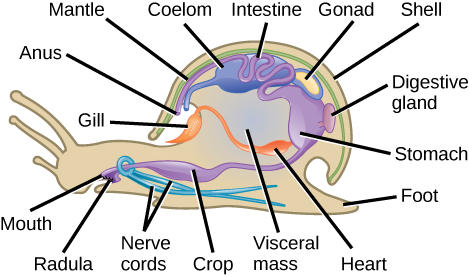
The animals having soft bodies with shell as a covering belongs to
A. Echinodermata
B. Mollusca
C. Porifera
D. None of the above
Answer
513.9k+ views
Hint: The molluscs have a calcareous shell covering the body. However, a soft and spongy layer of skin is present over the visceral hump of molluscs, forming the mantle.
Complete answer:
Molluscs belong to phylum Mollusca of invertebrates. They are characterized by their soft body. Their body can be divided into three parts: a head, a body and a foot. Due to their soft body molluscs have evolved to possess many protective features as well.
These include the presence of a hard shell (but not all of them have a shell).
Molluscs such as clams, oysters, snails, mussels, and scallops all have shells.
The hard shell protects them from predators.
Additionally, some molluscs have adopted camouflage to protect themselves. There are some molluscs that use poison to paralyze their attackers (like cone snails and octopus).

Additional information: Mollusks can be divided into seven classes:
Aplacophora, Monoplacophora, Polyplacophora, Bivalvia, Gastropoda, Cephalopoda, and Scaphopoda.
These classes are differentiated by, among other criteria, the presence and types of shells they possess.
Therefore, the correct answer is option B. Mollusca.
Note: The soft body makes it difficult for molluscs to adhere to the substratum in terrestrial and in marine habitats as well.
Complete answer:
Molluscs belong to phylum Mollusca of invertebrates. They are characterized by their soft body. Their body can be divided into three parts: a head, a body and a foot. Due to their soft body molluscs have evolved to possess many protective features as well.
These include the presence of a hard shell (but not all of them have a shell).
Molluscs such as clams, oysters, snails, mussels, and scallops all have shells.
The hard shell protects them from predators.
Additionally, some molluscs have adopted camouflage to protect themselves. There are some molluscs that use poison to paralyze their attackers (like cone snails and octopus).

Additional information: Mollusks can be divided into seven classes:
Aplacophora, Monoplacophora, Polyplacophora, Bivalvia, Gastropoda, Cephalopoda, and Scaphopoda.
These classes are differentiated by, among other criteria, the presence and types of shells they possess.
Therefore, the correct answer is option B. Mollusca.
Note: The soft body makes it difficult for molluscs to adhere to the substratum in terrestrial and in marine habitats as well.
Latest Vedantu courses for you
Grade 11 Science PCM | CBSE | SCHOOL | English
CBSE (2025-26)
School Full course for CBSE students
₹41,848 per year
Recently Updated Pages
Master Class 11 Business Studies: Engaging Questions & Answers for Success

Master Class 11 Economics: Engaging Questions & Answers for Success

Master Class 11 Accountancy: Engaging Questions & Answers for Success

Master Class 11 Computer Science: Engaging Questions & Answers for Success

Master Class 11 English: Engaging Questions & Answers for Success

Master Class 11 Maths: Engaging Questions & Answers for Success

Trending doubts
Which one is a true fish A Jellyfish B Starfish C Dogfish class 11 biology CBSE

The flightless birds Rhea Kiwi and Emu respectively class 11 biology CBSE

Difference Between Prokaryotic Cells and Eukaryotic Cells

1 ton equals to A 100 kg B 1000 kg C 10 kg D 10000 class 11 physics CBSE

One Metric ton is equal to kg A 10000 B 1000 C 100 class 11 physics CBSE

1 Quintal is equal to a 110 kg b 10 kg c 100kg d 1000 class 11 physics CBSE




